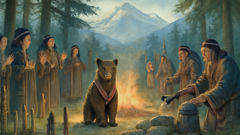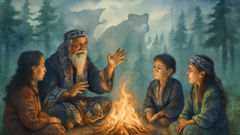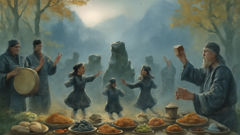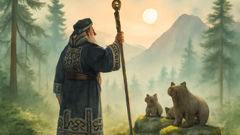Introduction
Far to the north of Japan’s main islands, where the forests of Hokkaido breathe ancient secrets and mountain mists cling to the silent pines, the Ainu people have woven their lives around the rhythm of nature and the spirits they believe dwell within it. For centuries, their world has been defined not just by the land’s beauty but by its mystery—a place where every river, tree, and animal is alive with kamuy, sacred spirits that shape the flow of seasons and fortune. Among these spirits, none looms larger in heart and legend than Kim-un Kamuy, the formidable bear god and guardian of the mountains. To the Ainu, Kim-un Kamuy is more than just a deity; he is the axis around which life turns, a symbol of strength, renewal, and the fragile balance between giving and receiving from the earth. This is not a story of conquest or domination, but of respect—a bond forged in rituals, songs, and the gentle dance between hunter and hunted. To step into the world of the Ainu is to walk under the silent gaze of snow-capped peaks, to hear the wind move through ancient cedar groves, and to sense, in every shadow, the presence of something both wild and deeply wise. Here, the tale of Kim-un Kamuy is not only a myth but a living guide—a reminder that every gift from nature demands gratitude, that every life taken must be honored, and that, above all, the world is held together by unseen ties of reverence and reciprocity. As you journey through this story, you’ll find yourself drawn into sacred rituals where bear cubs are gently raised and returned to the gods, witness the quiet strength of Ainu hunters, and sense the quiet power of the bear god watching from the mountain’s heart. In the flickering firelight of village gatherings, in the hush of dawn rituals, and in the enduring spirit of the land, Kim-un Kamuy’s story unfolds—timeless, haunting, and alive in every breath of the northern wind.
Kim-un Kamuy: Lord of the Mountains and Bears
The Ainu’s reverence for Kim-un Kamuy runs deeper than mere legend—it shapes every facet of daily life, binding people and place through ritual and awe. In their language, Kim-un Kamuy means 'God of the Mountains,' but his form is that of the brown bear, a creature both feared and cherished. To the Ainu, bears are not simply animals; they are physical vessels for the divine, the very presence of the god made tangible in fur, muscle, and golden eyes.

Every spring, as the snow melts and rivers swell with icy water, the bear’s return from hibernation is awaited with anticipation and a certain sacred tension. The Ainu believe that Kim-un Kamuy descends from the spirit realm, choosing a bear’s body to walk among them. When a hunter encounters a bear in the forest, the moment is heavy with meaning—it’s not just a meeting with a beast, but an audience with a god. The act of hunting itself is transformed: every arrow notched, every step in the undergrowth, is part of a conversation with the spirit world.
Ainu villages nestle at the feet of steep mountains, their thatched houses built to withstand cold winds and drifting snow. The people move through their days guided by rituals—chants whispered at the forest’s edge, wooden ikupasuy prayer sticks carved with clan symbols, and offerings of sake poured out for the kamuy. In these ceremonies, Kim-un Kamuy is honored as both protector and provider. He watches over the forests, ensures bountiful game, and grants safety to those who remember their place in the world’s intricate web. The bear’s image appears everywhere: painted on drums, carved into doorways, etched into bone and wood. Children grow up hearing stories of the bear god’s strength, his wisdom, and his unpredictable mercy. The line between animal and divinity blurs until every rustle in the undergrowth could be a sign—a message from the mountains themselves.
Perhaps nowhere is the relationship between the Ainu and Kim-un Kamuy more poignant than in the ritual known as iomante. When a bear cub is found in the wild—sometimes orphaned, sometimes gently captured by skilled hunters—it is brought back to the village and raised with care, even affection. For a year or more, the cub is fed, sung to, and treated as a cherished guest. The women of the village cradle it in their arms, children run alongside as it plays, and the elders offer prayers. All the while, the people know that the bear is not merely an animal but a spirit on loan, destined one day to return to the realm of the gods.
The iomante ceremony is both solemn and joyful. On the appointed day, the village gathers at dawn. Fires are lit and songs rise to greet the sky. The bear, now full-grown and resplendent, is adorned with sacred woven sashes and brushed until its coat gleams. Prayers are recited, sake is offered, and the hunters who will carry out the final task move with slow, deliberate grace. The act of sending Kim-un Kamuy’s spirit back to the heavens is performed with deep respect—never hurried, never careless. The bear is thanked for its sacrifice, its flesh shared among the people as a blessing, its fur and bones transformed into sacred objects that ensure the god’s presence endures in the village long after the last song fades. For the Ainu, this is not an act of cruelty but of love—a recognition that life flows in cycles, that giving and receiving are bound by sacred duty.
Through the changing seasons, the story of Kim-un Kamuy lives on in every corner of Ainu life. Hunters leave offerings at the forest’s edge before venturing out. Mothers whisper prayers for protection as they tuck their children in at night. Even in times of hardship—when blizzards howl and food grows scarce—the people remember the bear god’s promise: respect the world and it will sustain you. The mountains rise silent and eternal, their slopes watching over the villages below. In every shadow, every breeze, the spirit of Kim-un Kamuy lingers—a living thread that ties the Ainu to their land and to one another.
The Mountain’s Heart: Myths, Spirits, and Sacred Balance
To understand Kim-un Kamuy fully, it’s essential to explore how Ainu myths shape a worldview where the natural and spiritual are inseparable. The mountains themselves—craggy, green, and veiled in perpetual mist—are believed to be the dwelling places of countless kamuy, each with their own powers and personalities. Rivers sing with the voices of water spirits, ancient trees hum with memory, and stones are vessels for secrets older than memory. Yet, at the heart of this world stands Kim-un Kamuy, towering and omnipresent.

Stories handed down through generations tell how Kim-un Kamuy first descended from the upper world, drawn by the richness of earth’s forests and the sincerity of the people below. It’s said he taught the Ainu how to hunt with respect, showing that every arrow released should be accompanied by a word of thanks. He instructed them in the art of making inau—delicate prayer wands crafted from willow or birch, each one a tiny bridge between humans and kamuy. Through these rituals, the people learned that the world was not theirs to possess but to share in harmony.
Children grow up listening to tales of encounters with Kim-un Kamuy—not always as a great bear but sometimes as a whisper on the wind or a fleeting shadow at dusk. In some stories, he tests hunters by taking on impossible forms or leading them deep into the forest’s maze. The wise hunter is the one who listens to signs, who never takes more than needed, and who offers prayers whether successful or not. The foolish hunter—greedy or disrespectful—risks angering the god, inviting misfortune or even disappearance into the mountains.
Rituals are woven through every season. In spring, villagers leave offerings at mountain shrines: salmon, millet cakes, wildflowers arranged on woven mats. During harvest, gratitude is shown for berries, roots, and medicinal herbs gathered from the wild. Each act of consumption is balanced by a gesture of respect—a portion returned to the earth, a song sung to the trees, a promise to preserve what remains for future generations.
The spiritual life of the Ainu is not confined to ceremonies. It permeates daily acts—carving a spoon from ash wood, gathering firewood, setting a fish trap in a bubbling stream. Even laughter and storytelling around the hearth are part of this sacred balance. In these moments, Kim-un Kamuy is always present: as protector, as witness, as the quiet force that binds people to place. The mountain’s heart beats in rhythm with every life in the village, human and animal alike.
In times of trial—when storms batter the land or sickness strikes—the people turn to Kim-un Kamuy for guidance. Elders consult omens, interpreting the movements of birds or the way clouds gather on distant peaks. Sometimes, dreams bring messages: visions of a great bear walking among the stars, or a voice urging patience and humility. When hunters return empty-handed, they offer extra prayers to appease any offense, believing that even misfortune is a sign—a lesson in gratitude and interdependence.
As night falls over the mountains, the firelight inside each house glows like a beacon. Families gather to share food blessed by the bear god, their voices rising in song. The world outside grows still, yet alive with unseen presence. In this world—woven from myth and memory—Kim-un Kamuy is more than legend. He is the spirit of the mountains, the echo of respect in every gesture, and the living bond that sustains the Ainu through all seasons.
Cycles of Life: Ritual, Remembrance, and Renewal
As the years turn and generations pass, the relationship between the Ainu and Kim-un Kamuy endures—rooted in cycles of life and renewal that stretch beyond memory. The bear god’s presence is felt most strongly at moments of transition: birth and death, the first hunt of spring, the final harvest before snow.

From infancy, Ainu children are steeped in stories and rituals that teach respect for all living things. Grandmothers sing lullabies invoking Kim-un Kamuy’s protection, their voices carrying through smoke-hazed rooms as infants drift into dreams. Young boys learn to carve prayer sticks from willow branches, their hands guided by patient elders. Girls gather wild herbs and learn which berries to leave for birds and which to pick for medicine. In all things, the lesson is the same: take only what you need, give thanks for every gift, and remember that every life is sacred.
The passage into adulthood is marked by new responsibilities—and new rituals. For boys, the first successful hunt is cause for celebration and solemnity. An elder might recount how Kim-un Kamuy once appeared in a dream to bless a hunter who offered the choicest meat back to the earth. For girls, rites of passage often involve weaving sashes or preparing sacred foods for ceremonies, each thread and grain a prayer for harmony.
Death, too, is woven into the sacred cycle. When an elder passes away, the village gathers to send their spirit on its journey. Offerings of sake and millet are placed at the grave, and a carved bear effigy stands watch to guide the departed safely to the spirit realm. Mourners sing old songs—some joyous, some aching with longing—while children scatter wildflowers among the stones. Even in grief, there is gratitude: for a life well-lived, for lessons taught, for the ever-present watchfulness of Kim-un Kamuy.
The land itself changes with the seasons, but the rituals remain. In spring, young hunters trek into the mountains with prayers for luck; in summer, families gather wild garlic and salmon from rushing streams. Autumn brings a festival of thanks—a time to remember ancestors and renew promises to protect the forests and rivers. When winter descends, blanketing the world in snow, villagers huddle together around fires, sharing stories that keep memory alive.
Modern times have brought challenges to Ainu traditions. Outside influences threaten old ways, and the forests themselves have changed. Yet, amid these changes, many Ainu still hold fast to their rituals and beliefs. Iomante ceremonies are conducted with care—sometimes as private family events, sometimes as public festivals meant to educate and inspire. Younger generations learn ancient songs alongside new skills; elders pass on not just knowledge but a deep sense of belonging to land and story.
The cycle continues: birth to death, spring to winter, giving and receiving. Through it all, Kim-un Kamuy endures—a living presence in every ritual act, every whispered prayer, every footstep taken with respect across the sacred mountains of Hokkaido.
Conclusion
The story of Kim-un Kamuy isn’t just an echo from a distant past—it’s a living thread that still binds the Ainu people to their land, their traditions, and each other. Through every ceremony, every whispered prayer, and every mindful step taken in the mountains’ shadow, the bear god’s presence reminds them that true strength lies in balance, gratitude, and humility before nature. Even as the world changes and new challenges arise, these ancient values endure—passed down in lullabies and legends, honored in rituals that celebrate both life’s gifts and its inevitable cycles. To honor Kim-un Kamuy is to honor the earth itself: to give thanks for each meal, to share what one has, to respect every living being as part of a greater whole. The mountains still stand silent watch over Hokkaido, their slopes alive with memory and spirit. In every rising sun and falling snow, in every tale told by firelight, the legacy of the Ainu bear god endures—a powerful reminder that humanity’s truest home is found not in mastery over nature, but in reverence for its mysteries.













